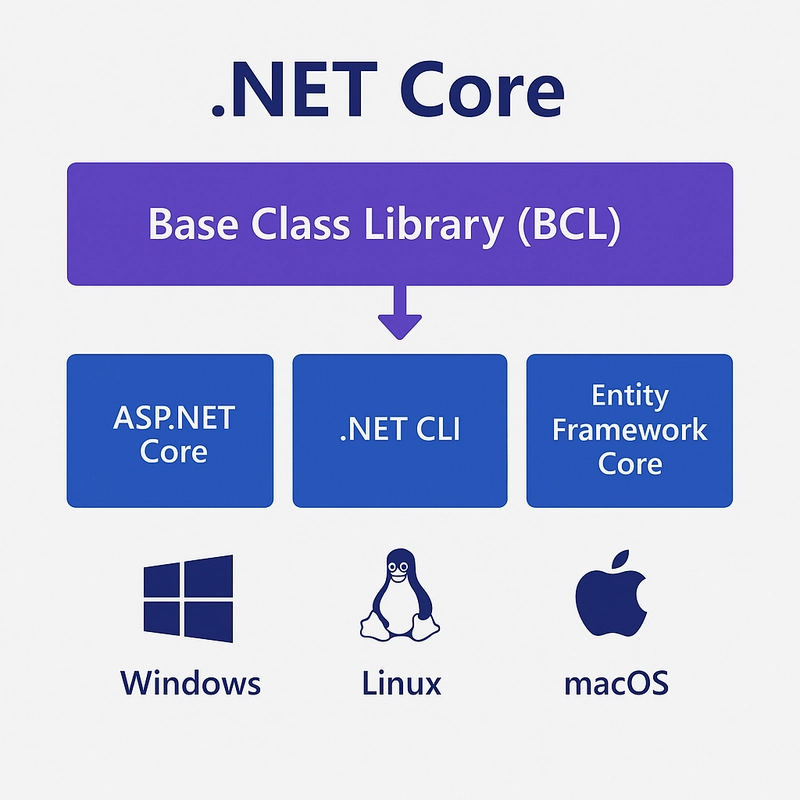.NET has come a long way since its inception in 2002. What started as a monolithic Windows-only framework has grown into a powerful, cross-platform, cloud-native, and open-source ecosystem used by millions.
In this post, we’ll journey through the major milestones of .NET - understanding where it started, how it evolved, and where it’s heading with .NET 8 and beyond.
1. The Birth of .NET Framework (2002)
The original .NET Framework 1.0 was released in 2002 with the goal of simplifying Windows development.
Key Innovations:
- Common Language Runtime (CLR) — Managed code execution
- Base Class Library (BCL) — Rich core APIs
- ASP.NET Web Forms — Web UI abstraction
- Windows Forms — GUI for desktop apps
🚫 Limitation: Windows-only, heavyweight deployment, difficult versioning.
2. Cross-Platform Pressure and Mono
As developers craved cross-platform tooling, the Mono project emerged - an open-source implementation of the .NET Framework, originally created by the community.
Eventually, Microsoft embraced this momentum by acquiring Xamarin and rethinking the future of .NET from the ground up.
3. .NET Core: The Modern Reboot (2016–2019)
In 2016, Microsoft launched .NET Core, a modern, modular, and cross-platform reimagining of .NET.
🔑 Key Features:
- Cross-platform (Windows, Linux, macOS)
- Lightweight and modular via NuGet
- CLI-first developer experience
- Side-by-side versioning
- Open-source and community-driven
Example:
dotnet new webapi -n HelloWorldApi
cd HelloWorldApi
dotnet run
.NET Core steadily grew from version 1.0 to 3.1, eventually supporting desktop (WPF/WinForms) and web (ASP.NET Core, Razor Pages, Blazor).
4. The Unified Future: .NET 5 & .NET 6
In 2020, Microsoft dropped the "Core" branding with the release of .NET 5, kicking off the vision of a unified platform.
Then came .NET 6 in 2021 - an LTS (Long-Term Support) release that delivered:
- Minimal APIs
- Blazor improvements
- Hot reload
- Global using directives
- .NET MAUI preview for cross-platform apps
.NET 6 solidified the modern .NET development experience, enabling a full-stack approach across web, cloud, desktop, and mobile.
5. .NET 7: Performance and Developer Productivity
Released in 2022, .NET 7 focused on performance and productivity improvements for developers building high-scale applications.
Highlights:
- On-stack replacement (OSR) for faster runtime optimisations
- Rate limiting middleware in ASP.NET Core
- Improvements to minimal APIs
- Updates and refinements to MAUI and Blazor
- Native AOT enhancements for smaller, faster apps
While not an LTS release, .NET 7 paved the way for .NET 8’s long-term vision.
6. .NET 8: Cloud-Native, AI-Ready, and Future-Proof (2023)
.NET 8, released in November 2023, is an LTS release that represents the most complete and mature version of modern .NET at the time.
Cloud-Native Features
- Native AOT support with improved trimming and faster startup
- Full support for WebAssembly and hybrid apps (WASM + server)
- Built-in telemetry via OpenTelemetry
Built-In AI Integration
- Integration with ML.NET, ONNX, and Azure AI Services
- Easily build AI-enhanced applications using CoPilot, OpenAI and other models
Full-Stack with Blazor United
Blazor United combines server-side rendering and client-side interactivity into a flexible, performant model:
- Server + WebAssembly hybrid rendering
- Streamlined state management
- Faster load times and simplified deployments
New C# 12 Features
// Primary constructors for non-records
public class Product(string Name, decimal Price);
// Collection expressions
var numbers = [1, 2, 3, 4];
// Alias any type
using Coordinate = (int X, int Y);
Enhanced .NET MAUI
- Better support for Android, iOS, macOS, and Windows
- Performance improvements across the board
- Streamlined cross-platform UI development
7. What's Next? The Future of .NET
With the release of .NET 9 in November 2024, it adds:
- AI and ML as core workloads
- Enhanced native interop and low-level performance
- Blazor continues evolving as a unified full-stack framework
- Innovations in energy-efficient computing and sustainable execution
But more than features, the real power of .NET lies in its developer community:
- Open-source contributions on GitHub
- Microsoft MVP program
- .NET Foundation community projects
- Local user groups and global conferences
Summary Table
| Version | Year | Highlights |
|---|---|---|
| .NET Framework | 2002 | Windows-only, CLR, BCL |
| .NET Core 1–3 | 2016–2019 | Modular, cross-platform, CLI, open-source |
| .NET 5 | 2020 | Unified platform begins |
| .NET 6 (LTS) | 2021 | MAUI preview, Minimal APIs, Hot reload |
| .NET 7 | 2022 | Blazor/MAUI updates, OSR, Native AOT |
| .NET 8 (LTS) | 2023 | Cloud-native, AI-ready, Blazor United |
| .NET 9 | 2024 | AI-first, Blazor evolution, Energy-efficient runtime |
💬 Final Thoughts
.NET’s evolution over the last 20+ years is a testament to Microsoft's transformation and its investment in open-source, cross-platform development.
From building web APIs, cloud-native microservices, desktop apps, to even AI-powered tools - modern .NET is a one-stop platform for it all.
Whether you're a .NET veteran or just getting started, there's never been a better time to get involved.
🙌 Let’s Connect
- 🧠 More posts on dev.to
- 🔗 Follow me on LinkedIn
- 💬 Drop a comment or reach out—what are you building with .NET 8 or even 9?





Top comments (0)